 Ed Halter
Ed Halter
In the German artist’s works confronting historical violence, a serious side to the Fluxus movement.
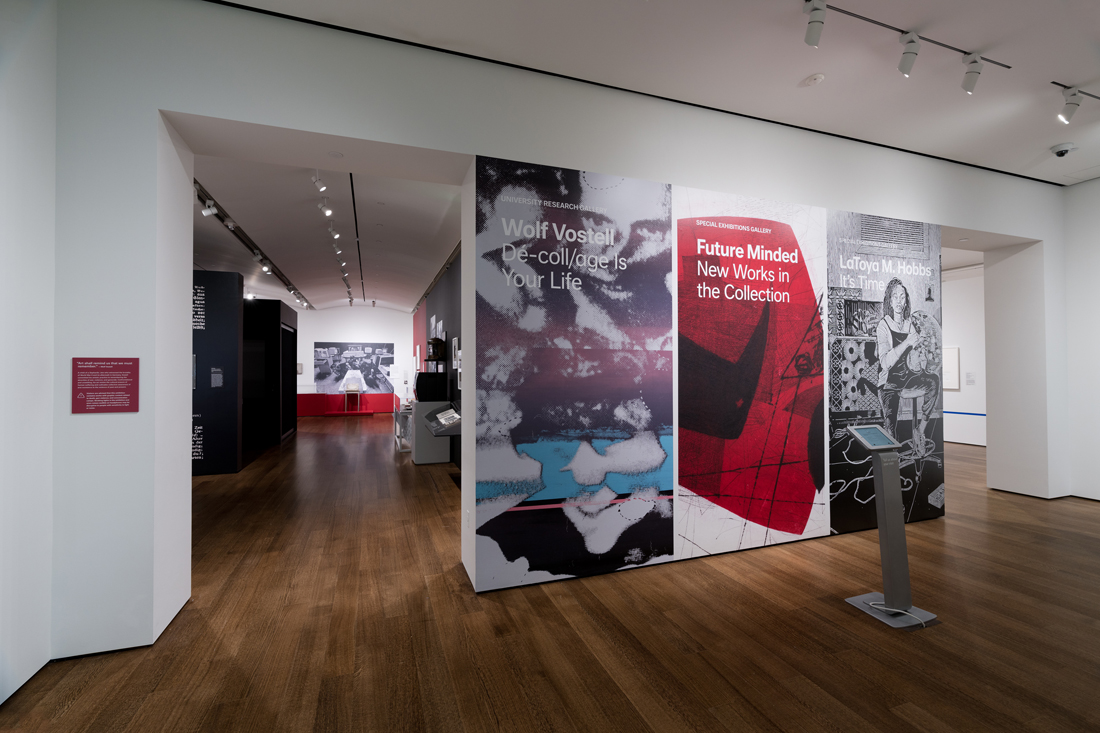
Wolf Vostell: Dé-coll/age Is Your Life, installation view. Courtesy Harvard Art Museums. © President and Fellows of Harvard College.
Wolf Vostell: Dé-coll/age Is Your Life, Harvard Art Museums, curated by Kyle Stephan, Harvard Art Museums, 32 Quincy Street, Cambridge, MA, through May 5, 2024
• • •
The international art movement Fluxus is usually cited for its more playful, performative aspects, clever graphics, and sideways comedy. George Maciunas, a Fluxus originator and its primary hype man, famously described the group’s sensibility in a 1965 manifesto as “a fusion of Spike Jones, gags, games, Vaudeville, Cage and Duchamp.” But the Harvard Art Museums’ current exhibition of a different Fluxus founder, German artist Wolf Vostell, demonstrates that such Dadaistic ludism could just as well be applied to deadly serious concerns. For Vostell, if art is a game, it’s not one pursued merely for fun, but rather as a ritualized process by which we exhume and confront the violence of the past.
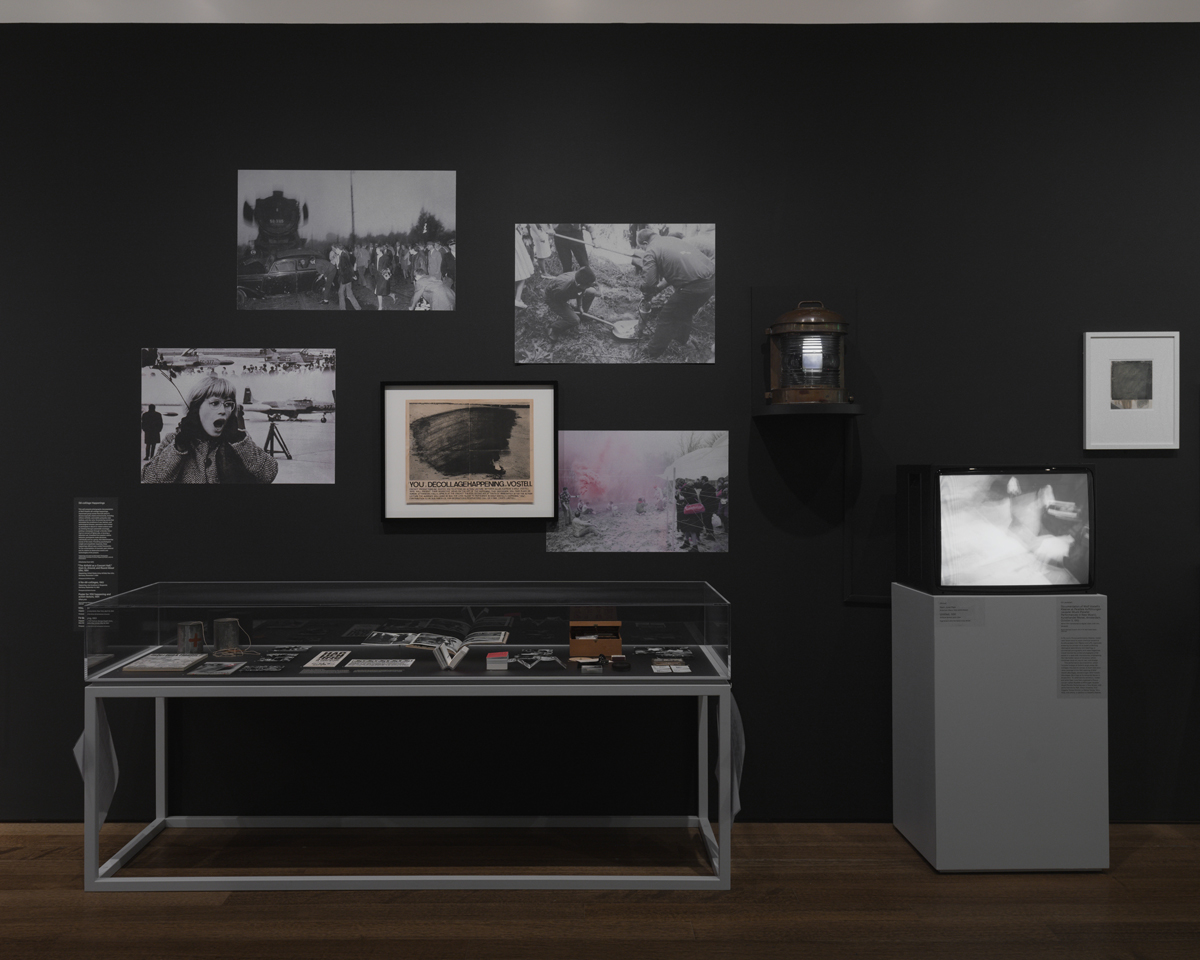
Wolf Vostell: Dé-coll/age Is Your Life, installation view. Courtesy Harvard Art Museums. © President and Fellows of Harvard College.
Making sure this point is clear, Wolf Vostell: Dé-coll/age Is Your Life greets visitors with a red plaque bearing a quote by the artist in bold type—“Art shall remind us that we must remember”—followed by a cautionary warning, punctuated with an exclamatory triangle, that the show will present “graphic content related to death, gun violence, and concentration camps.” The show indeed confronts the viewer with some heavy stuff: rough concrete slabs, harsh chemical abrasions, altered photographs of military bombers, urban rubble, and atrocities from the Holocaust and the Vietnam War, black-and-white videos that strobe and hum with electronic interference. Taken as a whole, it’s a grim reassemblage of the twentieth century’s moral and material ugliness, tightly cornered inside the limits of a single room.
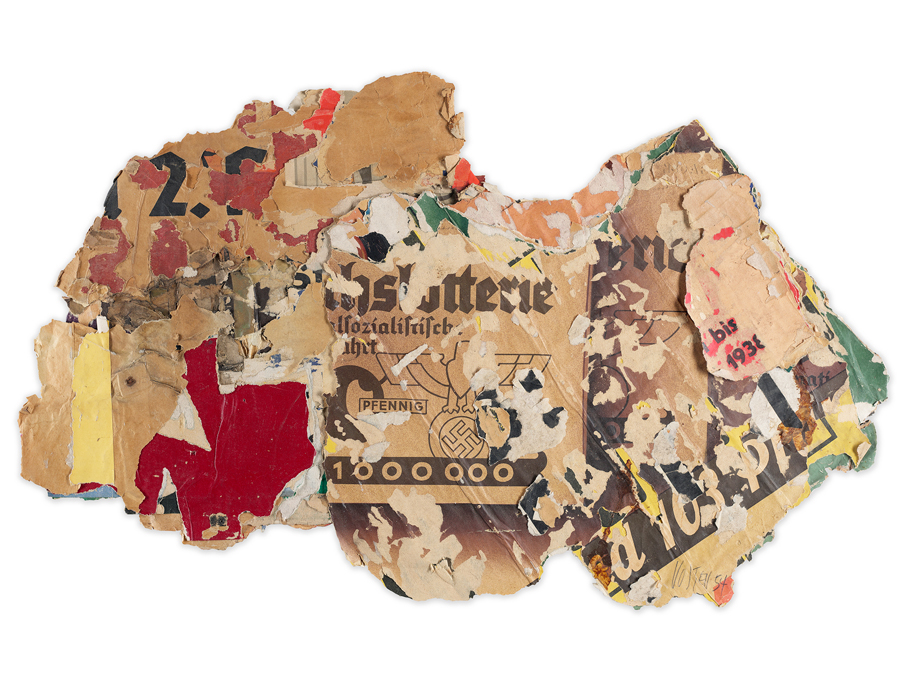
Wolf Vostell, Fall and Rise and Fall, 1954. Décollage, assembled; paper, plexiglass, and posters. Photo: LWL-Museum für Kunst und Kultur / Hanna Neander. © Wolf Vostell Estate.
Born in Germany in 1932 and raised in Czechoslovakia during the war, Vostell relocated to Paris in the 1950s. There, prior to the beginnings of Fluxus in the 1960s, he moved in a circle of like-minded young artists known as the affichistes, so called for their penchant for removing torn, layered posters (affiches) from the streets and framing them as readymade abstractions. They termed these acts of creation through subtraction décollage, a kind of collage in reverse. Vostell’s participation in this moment is represented by the potent Fall and Rise and Fall (1954), consisting of a two-foot-wide multicolored scrap of wheat-pasted fliers, found in Cologne, sandwiched between plexiglass plates. At first glance, the clump seems not unlike any worn-down admixtures of past and present advertisements one might encounter on urban exteriors today. In Vostell’s chosen shred, however, the damage peeks backward to 1938, revealing an eagle atop a swastika promoting the Nazi state lottery. It is a stunningly literal demonstration of how repressed histories persist beneath the thin surfaces of everyday life.
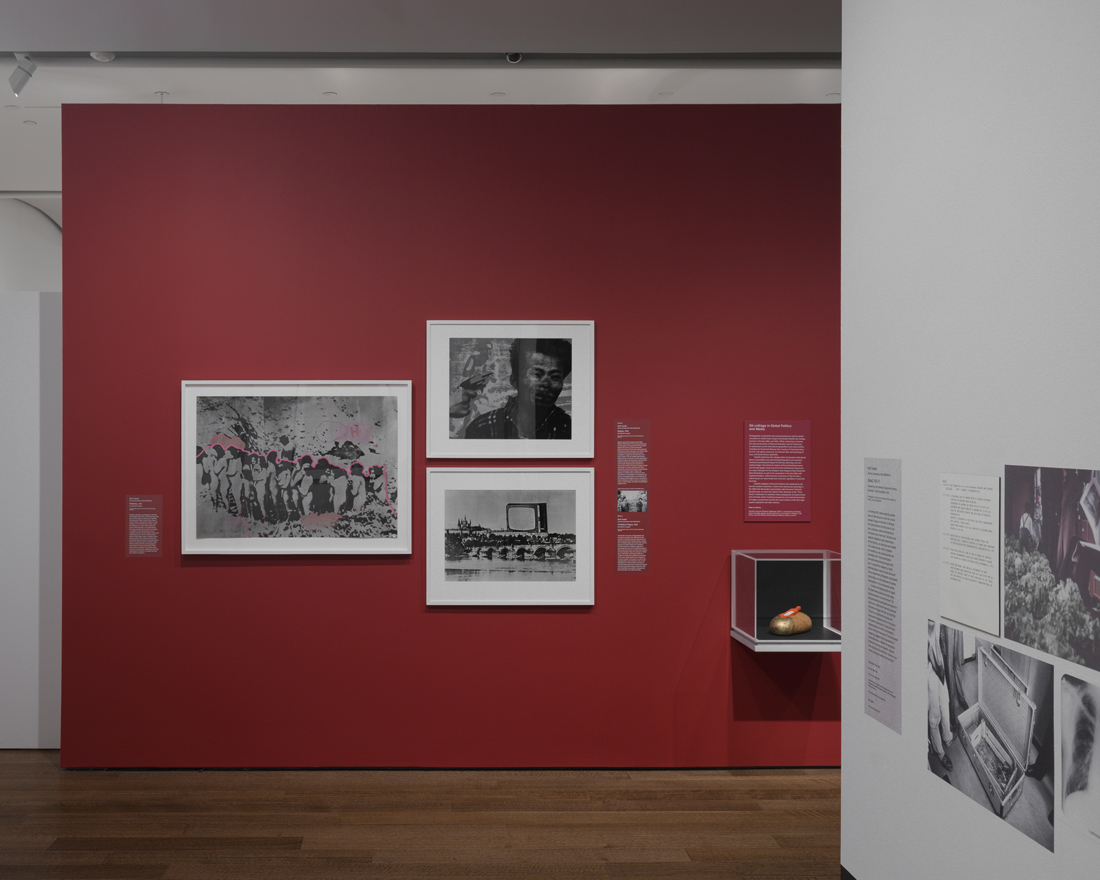
Wolf Vostell: Dé-coll/age Is Your Life, installation view. Courtesy Harvard Art Museums. © President and Fellows of Harvard College. Pictured, clockwise from left: Treblinka, 1967; Saigon, 1969; Hradčany Prague, 1969.
As Vostell’s work evolved, décollage became for him dé-coll/age, styled as if the word itself were crumbling into shored-up fragments, to stress what the show’s opening statement calls “the use of destruction in art to generate consciousness of destruction in life.” The concept would expand beyond street posters to include the disruption and rearrangement of other media: newspapers, magazines, broadcasts. His means of dismantling images were manifold. In Treblinka (1967), a blurred photo of naked concentration-camp inmates is covered by a decorative neon-pink line and meteorological symbols; the infamous photograph of Viet Cong officer Nguyễn Văn Lém’s gangster-style execution is cropped and superimposed with a vacation resort ad in Saigon (1969); and for Hradčany Prague (1969), Vostell montaged an enormous television set atop Prague Castle, a combination that the wall text says alludes to both the Nazi occupation of the city in 1939 as well as the 1968 Soviet-led invasion that crushed the Prague Spring. All three of these works are screen prints, that Pop medium par excellence. And, in true Pop fashion, their combination of stylish advertising and unblinking evidence provokes—but does not resolve—the relatably modern enigma of experiencing the world’s most profound horrors via the kitsch aesthetics of mass communication.
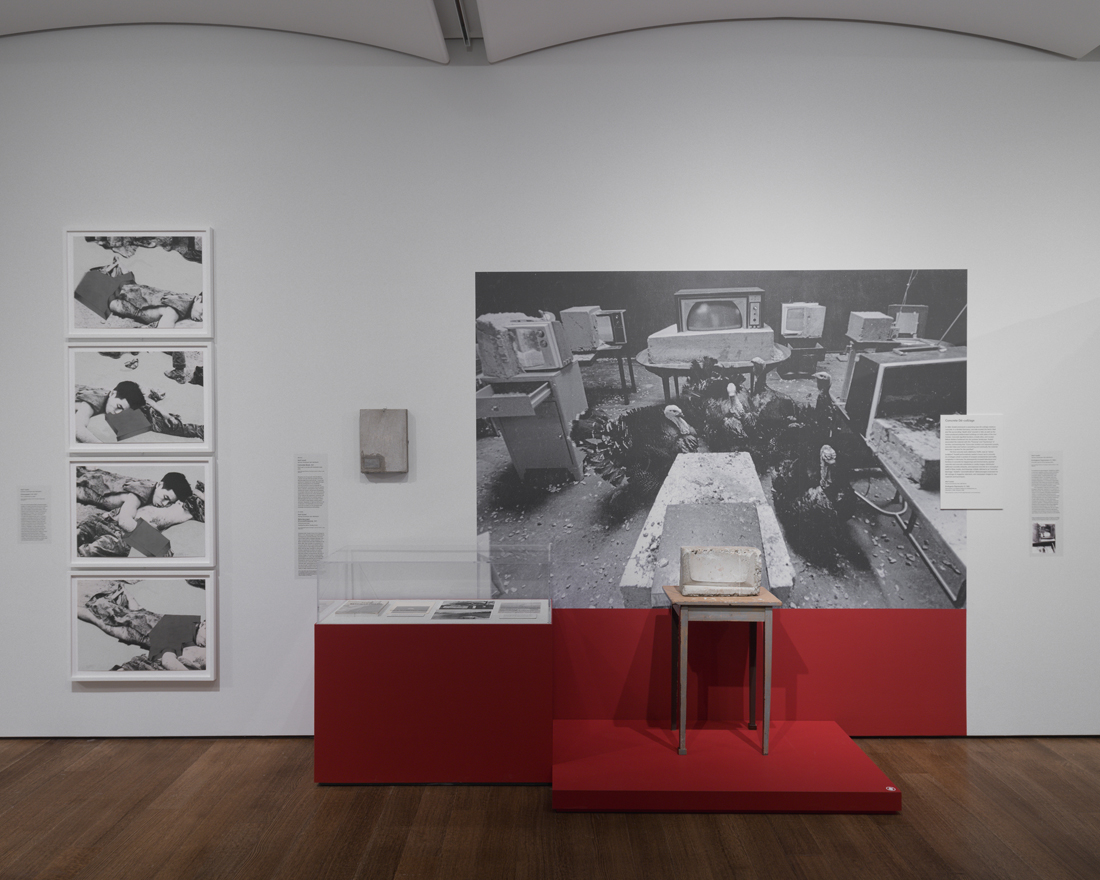
Wolf Vostell: Dé-coll/age Is Your Life, installation view. Courtesy Harvard Art Museums. © President and Fellows of Harvard College. Pictured, center left on wall: Concrete Book, 1971. Center right on platform: Endogene Depression V, 1980.
Given these concerns, Vostell unsurprisingly gravitated toward television. He is sometimes considered the first artist to do so, due to pieces he created in the late 1950s, like German View from the Black Room Cycle or TV-Dé-coll/age no. 1, that placed working cathode-ray sets inside physical structures. Neither of these appear in Harvard’s show, but it has installed a digitized version of Sun in Your Head (1963), Vostell’s 16mm film of a dé-coll/aged television set running distorted broadcasts of military propaganda, an exceptionally early moving-image record of video art. Far more striking are the remnants presented from Endogene Depression V (1980), a late Happening in which Vostell placed live turkeys in a room with operational TVs half-encased in concrete. The exhibition includes an enlarged photo of this compellingly absurd situation, as well as a lone hunk of concrete bearing the impression of its missing television, displayed on a wooden table. Concrete reappears in works like Concrete Book (1971), a loose-leaf publication enveloped in over twenty pounds of the stuff, and Concreted B-52 (1970), a screen print of American warplanes encrusted with gray-painted plaster. For Vostell, concrete and television make an alluring pair: one hard where the other is fluid, one dense and mute where the other is communicative, both equally ubiquitous to modern existence, both functioning to cover the past.
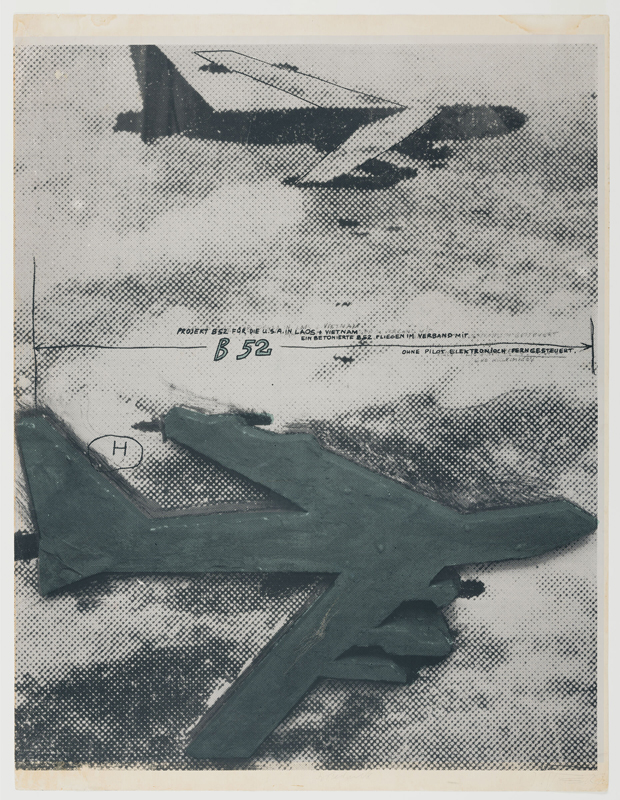
Wolf Vostell, Concreted B-52, 1970. Screenprint on paper. Courtesy Harvard Art Museums. Photo: President and Fellows of Harvard College. © Wolf Vostell Estate.
Because so much of Vostell’s work consisted of Happenings and other real-time, interactive, and environmental forms, Wolf Vostell: Dé-coll/age Is Your Life can feel like a collection of evidence, the catalogued mementos of an artist, and an art, no longer living. The Holocaust flattens into Vietnam, and Vostell’s role as witness to history begins to overtake his significance as critic and catalyst; the show shies away from more overtly engaged political work, like Vostell’s German Students Wallpaper (1967), created to protest police violence against student activists, though visitors were able to see this piece in the Museums’ permanent collection, on a different floor, until April 7. And a more optimistic version of Vostell appears in the opening pages of Fantastic Architecture, the 1969 book he coedited with fellow Fluxus artist Dick Higgins: “Our environments are meant to free man,” Vostell writes. “Only the realization of utopias will make man happy and release him from his frustrations! Use your imagination! Join in . . . . Share the power! Share property!” How we might digest this old hope remains an open but urgent question. Back in the twenty-first century, each day brings us new images of destruction from Gaza, a fresh genocide of which this exhibition never speaks directly, and yet inevitably evokes.
Ed Halter is a founder and director of Light Industry, a venue for cinema in all its forms in Brooklyn, New York, and Critic in Residence at Bard College in Annandale-on-Hudson, New York.